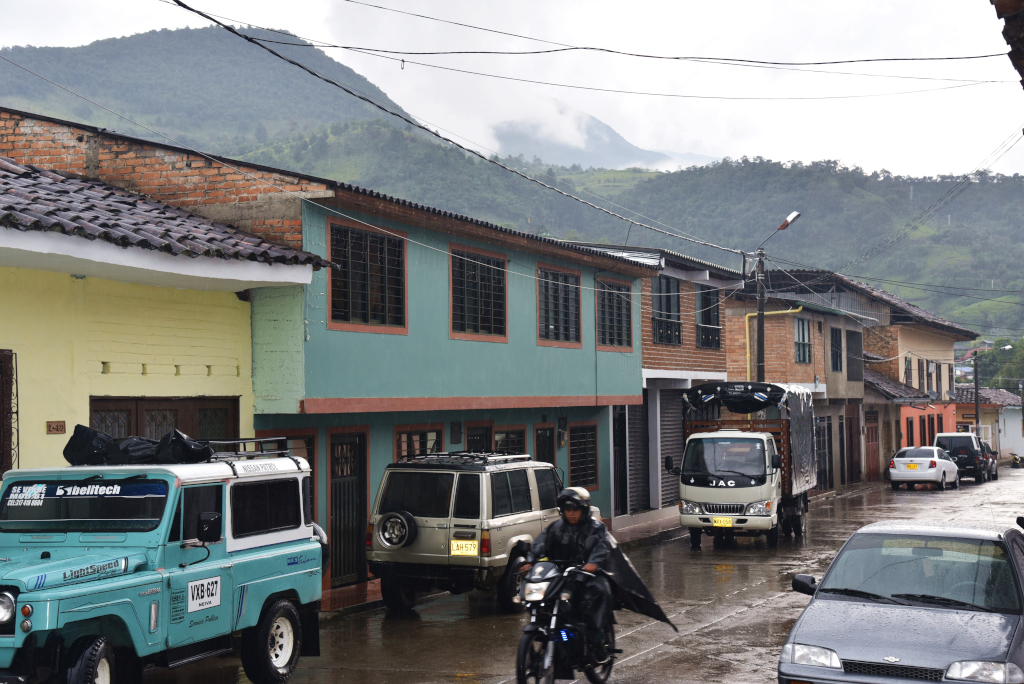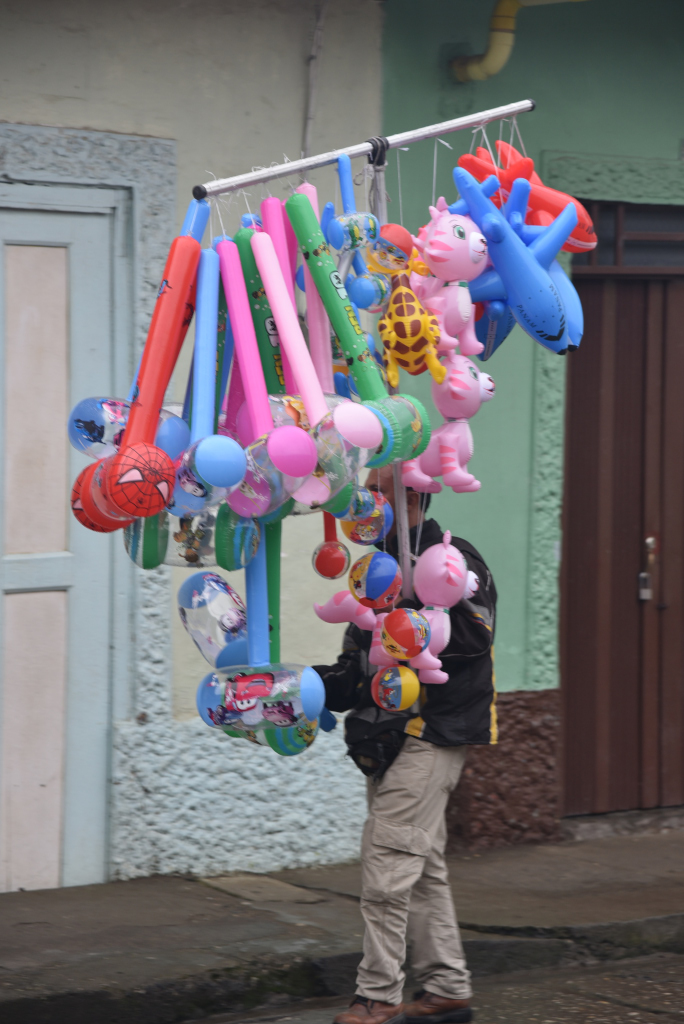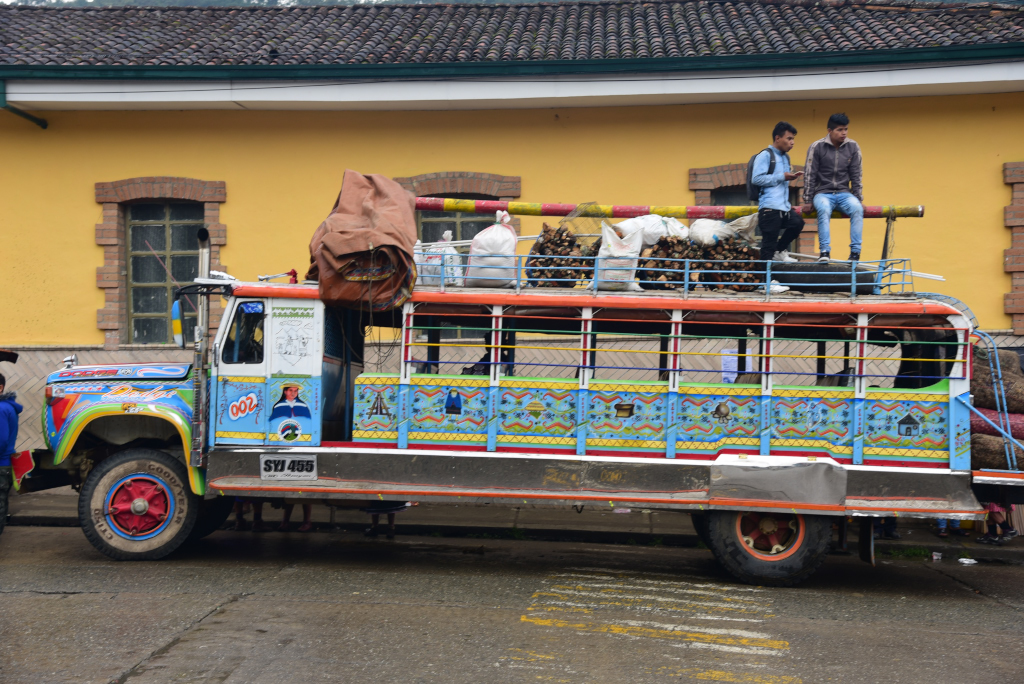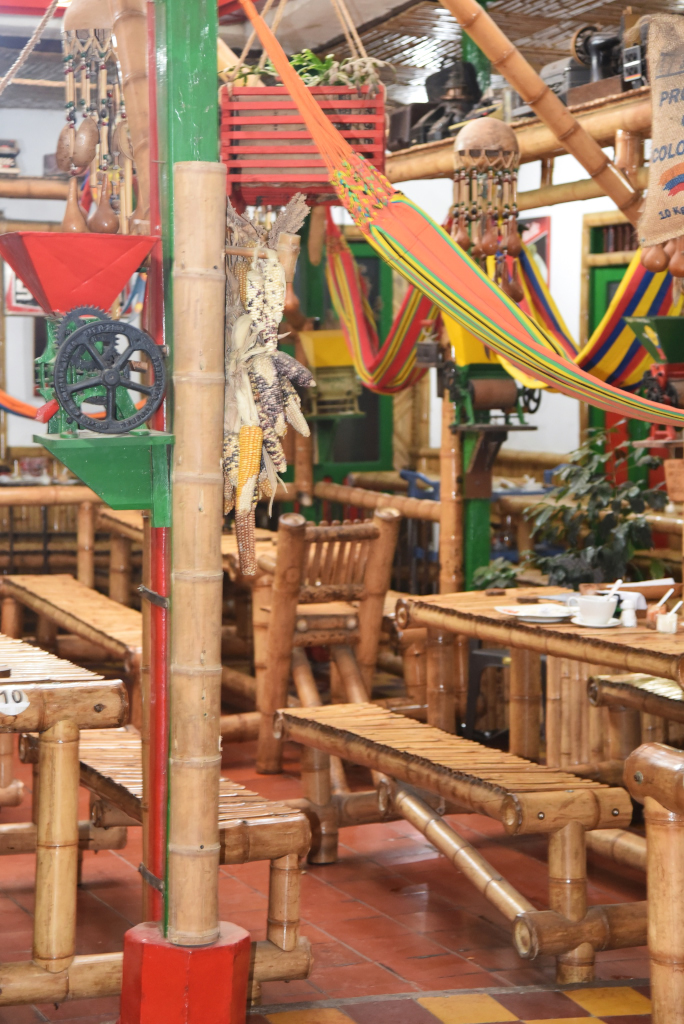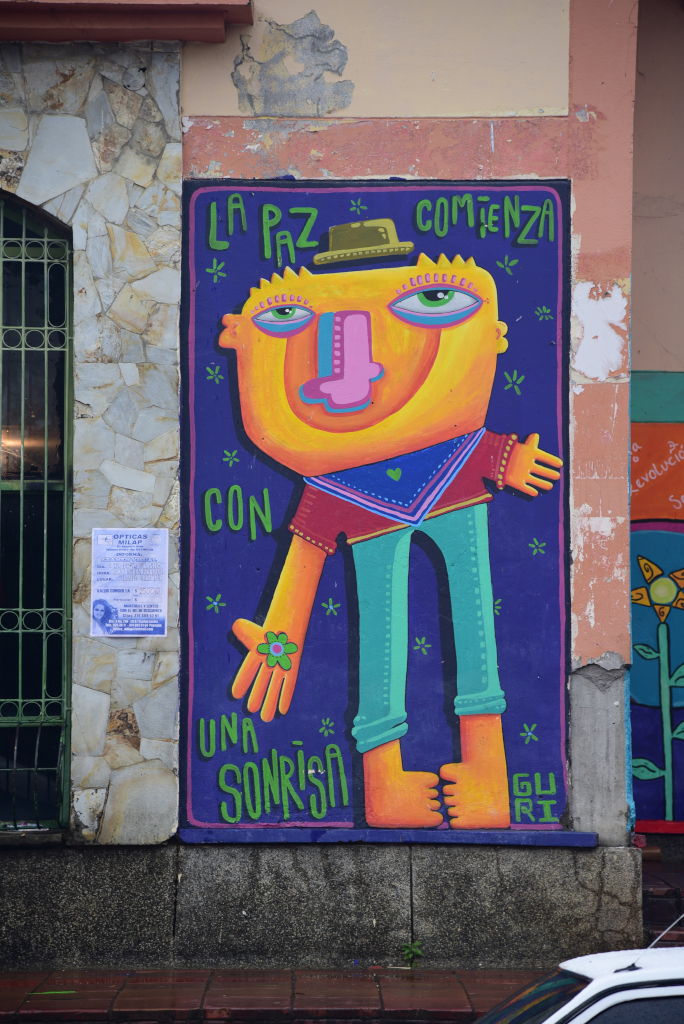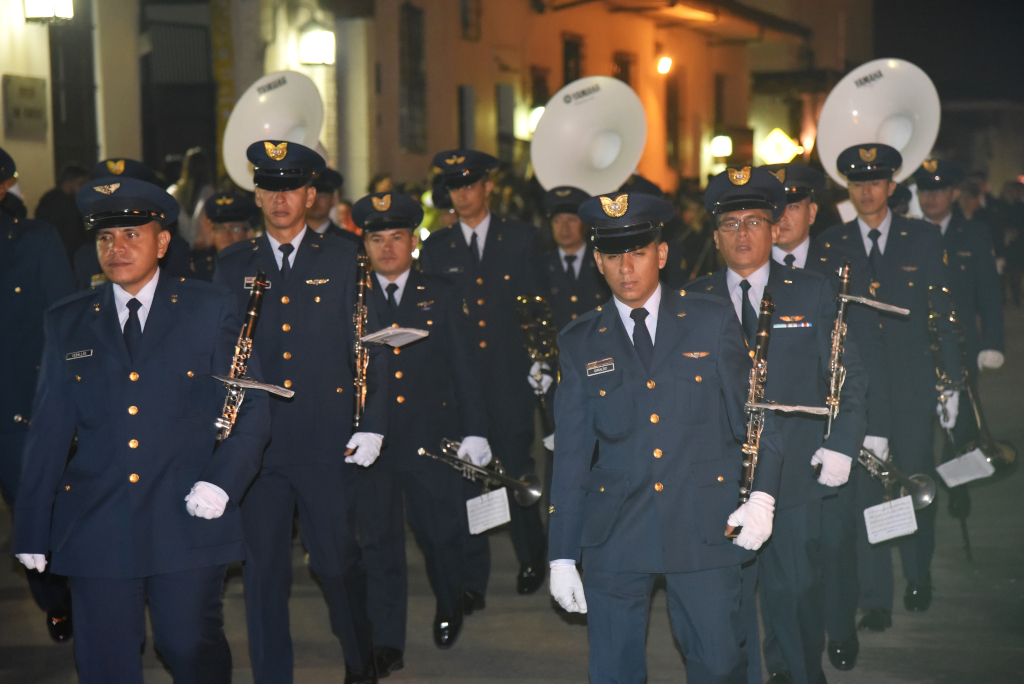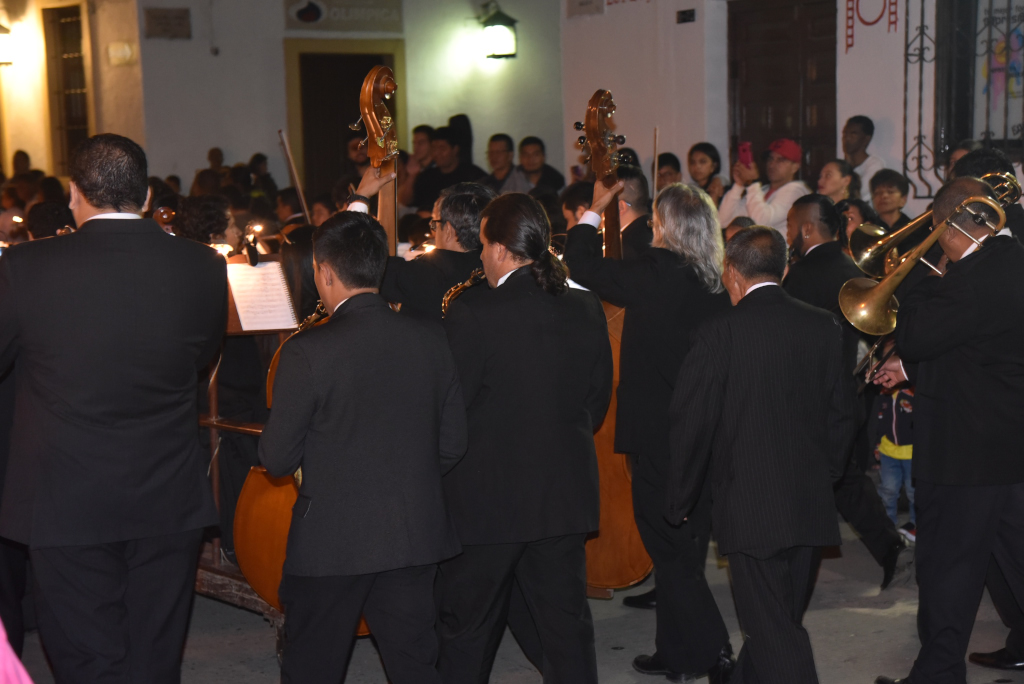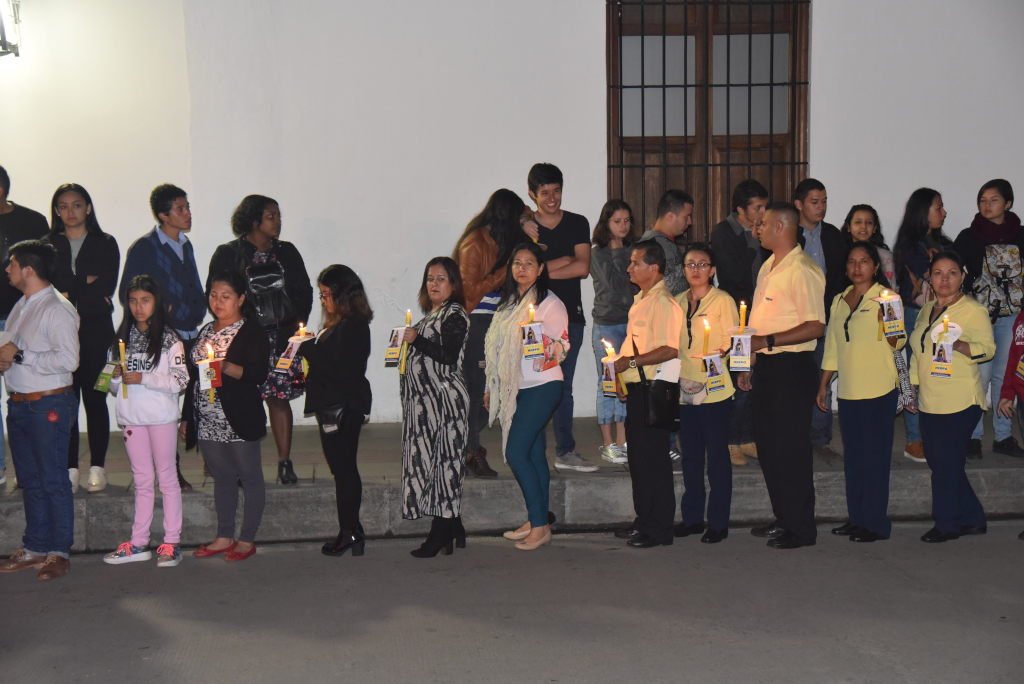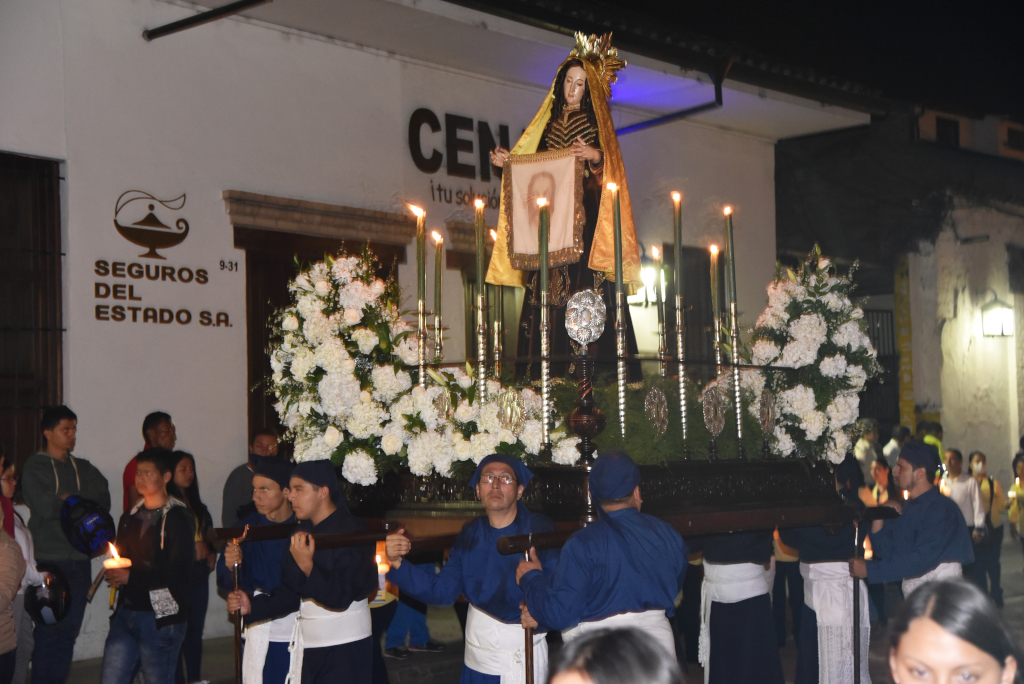March 27, 2018
I want to hail a cab to the bus station, as the station is too far to walk, but it seems as if the idea may be stillborn, due to the increased demand during the Semana Santa and the blockages in the town centre.
How about a bus? Perhaps the bus with a sign that includes ‘Terminal’ in its list of destination ambling further to the south, which within a block or so of my AirBnB becomes substantially rougher, probably not an area good to walk in any time of day. But we do arrive soon afterwards at the bus station, and then I am seated in the last row of a buseta, with limited views of the countryside as we pull out of Popayán. Next to me are hip young locals that live in Popayán and are also off to experience market day in Silvia. We share stories about music and cool events to go to, the delights of Colombia, in particular in the area of Santander where he originates from.
The road proceeds northwards towards Cali, quite innocuous in terms of the rolling countryside around us, and then at some point we branch off and begin rising, first through a relatively unsightly urban morass and then along the slopes and green ridges so typical for Colombia. Higher and higher we go, the landscape more dramatic while the vegetation becomes more uniform in the increasingly cooler climate. The overcast sky becomes dark and more foreboding, and sure enough, just as we descend from the bus in Silvia, the skies erupt with a massive downpour.
Silvia is a small town stretched along a ridge, the hills rising above to the west, and dropping to a small cheerful quebrada replete with colourful vegetation to the east and south, to which access to the Cali-Popayán highway is provided. The town itself is not green other than what I take to be the yellow trumpetbush trees in the parque principal, and of course the sea of colour offered by the trajes of the Guambiano people.
There is no way I will be able to do much in this rain other run for shelter to some covered place. This is definitely not the most attractive time to be traveling in the country, although most normal people don’t set out to do their sightseeing at noon, as I do, which is a perennial source of my problems.
I don’t make it far, encountering Alvaro draped in his poncho, telling me the rain is part of nature, and hence we should embrace it. Of course, he is right, although the ensuing tirade about the wrongs of the world becomes a bit trying. Yes, capitalism is the source of all evil – or is it? The reliance people have on vehicles, on technology, a curse – or panacea? The stranglehold agribusiness has on the rural populace is lamentable, but somewhere earlier on it also offered possibilities to the agricultural economy that people could only dream of. Are today’s youth mindlessly glued to their cellphones representative of society’s slide into an abyss – or is the universal acceptance of such technology and social media a fountainhead of opportunity?
What comes almost as a shock, the town is flooded with blue-caped indigenous people wearing bowler hats. The Guambiano people don’t necessarily live in the town, but come from their villages and fincas in the mountains to trade and socialize with their brethren. Their costumes are immaculate, which seems almost improbable for people living in presumably quite rudimentary circumstances. The people have unique dark, aquiline features that set them somewhat apart from their less striking Colombian brethren, although large numbers of rural Colombians have striking native features, without seeming to embrace particulars of their native heritage.
The sudden presence of such a large cohesive group of indigenous people is also a striking commentary on the loss of native culture in the country as a result of Spanish colonization and beyond, certainly in relationship to other Latin American countries which still have very strong indigenous cultures.
Faces are glued to TV screens showing the friendly match between Colombia and Australia in anticipation of the World Cup in Russia later this year, although no score arises on either side, despite the excited relentless chatter of the announcer. Unexpected are the wizened faces in the bright blue ponchos, crowned with bowler hats intent on this game that unifies much of the world.
The people are friendly but guarded, avoiding making direct eye contact and reserved in speech. This behavior changes when alcohol is introduced, and brazen drunkenness provides a counterpoint that is typically not seen amongst conventional Colombians (surprisingly). The Guambiano people seem to speak a mix of Spanish and their indigenous language, although I can’t make a very objective commentary on that front.
Beyond the black bowler hats and red-trimmed capes, the women wear black frocks. Both men and women wear the bowler hats, which may also alternate with flat reed hats embellished with discreet patterns that are slung over the back when not worn. An important characteristic of the attire is its immaculate presentation, although many of the particularly younger people wear regular working clothes. The women wear elaborate bead necklaces that focus on symmetrical florets created in a range of colours, that are also available for sale from small stands on the parque principal. I have seen this jewelry for sale throughout the country, and this is where it seems to originate.
There is a contingent of young people, hunched over the benches in the parque play with their phones, indifferent to the spectacle of their brethren, although they seem to watch me in a slightly mocking manner, highly unusual for Colombians, who are usually very reverential towards foreigners.
Tuesday is market day in Silvia, and as such is a huge tourist attraction, although I only see a straggling number of visitors. The market is far from interesting, just the regular produce being sold in a fairly bedraggled environment, but without being able to be the happy photographer, it loses its interest – never mind the fact that my camera does not seem to be able to take reasonable shots in the lower light, for reasons I am not motivated to research at the moment. I even get guarded looks when I point my camera at buildings, and in the end some colour does slip through as people walk through the frame en route to some destination.
Visitors are not supposed to take photos of the indigenous people, but the internet is full of pics of the these people, smiling for photos. So much for that degree of caution. And the light is so dull that photos look fairly awful anyway, the plight of the incoming rainy season.
The market is a shambolic affair, a mix of races presenting their wares on tables or the concrete floor of the market building. A large number of black Colombians are present, as Cauca is largely a departamento of the Pacific coast, and hence also home the to Afro-Colombian peoples who call the region home. Only the Guambino people are clad in their finery, which comes almost as a shock in the bedraggled market environment. I try taking some photos of the market area, but they look quite awful.
Vegetables include carrots, onions, squash, garlic, zucchini, beans, tomatoes, fruit pineapple, tomate de arbol, apples, grapes, granadilla, papaya, herbs parsley, oregano, verbena, and mint, and so on. There is an area where butchered meats are sold, another for clothing and dry goods, including panela, but there is really nothing unique about the market that would distinguish it from any other small town market in the country.
Parked in the cramped streets around the market are the colourful chiva buses that Colombia is famous for, rugged, wide-framed, with long bench seats and open sides, perfect for transporting large numbers of people with merchandise that can be stored both between the seats and on the roof. These huge, colourful vehicles are emblematic of the Colombian countryside, although are not used to transport people on major routes.
Arriving at the bus station in Popayán again, I make the mistake of asking a police officer if it would be feasible and safe to walk to town, rather than take a cab, given the state of the traffic. He quickly explains how to get to the town centre, not too far, but it will be easier if another police officer simply drives me downtown. I am taken aback – that really isn’t necessary! But I am already walking to his van, and very soon am walking along Calle 3 towards the centre, the fashionable restaurants and cafes of this regal town beckoning.
I see the floats of the Semana Santa approaching from the distance, the gilt frame of the float illuminated by the tall candles, and further back, yet another one, and so on, processions of candle-bearers lining the street on either side of the floats. The statues in the floats seem to represent the stations of the cross, so that the sequence would be important. Candle-bearers are typically in groups, including civic or governmental employees, affiliates of a particular church, security forces, students, and so on. Huge numbers are present, in the procession alone, which would suggest that many people must be coming from elsewhere – these people can’t all originate from Popayán.
The float bearers typically wear flowing robes in matching colours and head wrap in the same colour, with some wrap around the waist. In front of every float walks a usually very beautiful younger woman in a flowing gown, bearing a wreath of flowers in whose centre is nestled a bed of burning incense, which she blows continuously to unleash thick clouds of the sweet perfume.
The floats alternate with musical corps, including a drum and lyre ensemble, marching slowly in unison, the heavy drumming alternating with the shimmering sound of the lyre. In the distance, I can make out the strains of the ‘The Sound of Silence’, Simon and Garfunkle being quite the commodity with the Catholic church in Colombia. Another band consists almost exclusively of brass, while another orchestral ensemble is almost entirely housed on a driverless cart, a group of assistants pushing the cart along, providing somewhat of a surreal element. It is not clear to what extent the musical accompaniment is intended to imbue meaning to the procession, or simply an aesthetic accompaniment. Much but not all of the musical accompaniment is provided by military ensembles.
When the procession stops, the bearers on the cardinal ends of the floats drop the horizontal supporting poles onto vertical poles with semi-circular attachments intended to hold the weight of the float during the stationary period. I am assuming the procession moves slowly and with frequent stops, in order to make it easier for the float bearers. When the procession begins again, the lead bearer taps on one of the supporting poles, and all bearers swing their end of a supporting pole onto their shoulder. Judging from the look on some of the men’s faces, it can’t be too easy.
The young men I saw carrying long poles with unusual-looking attachments in fact are charged with scraping excess wax from the candles, presumably to avoid wax dripping onto the float bearers. Some degree of expertise must be involved in order to not break or cut the candles, which would be even worse.
The procession doesn’t look like it is about to end, and I really want to get back to the AirBnB and eat. It is well after 10 pm, and it really would have been nice to have started earlier. Although who knows what kind of hiccups the organizers of the procession experience beforehand. Leaving the parade is a bit of a delicate affair, as very large numbers of people are invested in this highly choreographed expression of faith, and to simply brazenly cross the street in the middle of the procession to make one’s way home may not be seen as too tactful. Yet later in the evening, the number of spectators diminishes substantially, and as the processions weaves back towards Parque Caldas on Calle 5, the surrounding sidewalks are largely empty.
I am going to have a very hard time trying to get everything done this week. I had been looking forward to spending a solid week in Popayán catching up, but the reality of sightseeing during the day, spending hours watching the religious processions, the afternoons marked by hours of torrential downpours will make the experience more difficult. At least I have the comfort of my AirBnB home to rely on …






